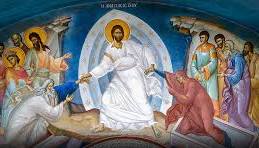
Christ is risen! Truly He is risen!
______________________________________

The Holy Martyrs the Priest Raphael, Irene and the Deacon Nicholas
commemorated on Bright Tuesday each year
Previously forgotten and unknown, these Fifteenth Century martyrs first revealed themselves to the world in 1959! This is an amazing, wonderful story. I wrote about it only a few years ago, but I don’t want anyone not to know about it. I get the holy chills every time I read the account.
It began in the year 1959, on the Greek island of Lesvos (also known as Mytilene). The Martyr Raphael appeared in a dream to the priest of the village of Thermi, identified himself, then began to tell him his story – how he and others had been martyred there by the Turks on Bright Tuesday, 1463, which fell that year on April 9. This was the beginning of many appearances to many people – both in peoples’ dreams and while they were awake – and the revelation of the full story.
First. the background. For as long as anyone could remember, on Bright Tuesday the villagers had gone to a nearby hill to pray. Nobody knew why. In the Old World, people often hang onto old customs like this, even if they don’t understand them. We’re not so wise over here.
There were ruins of a building there, and also vague memories of a monastery once having been there, but that was all. Shepherds and occasionally village people, even Turks, also told of seeing a monk walking up there from time to time, and some reported the faint sound of bells and the smell of incense. During the Ottomann occupation, the local Turkish authorities even conducted an investigation, but finally gave it up since there seemed to be no explanation.
Finally in the year 1959 a pious layman of the village, Angelos Rallis, decided to build a chapel there. In the process of excavating they discovered human bones. Mr Rallis, thinking they might be relics of some sort, had the man in charge of the excavations, one Doukas Tsolakis, put them carefully in a sack. Some accounts say that noises came from within the sack, and a sweet fragrance. One of the workmen, a non-believer, gave the sack a kick, and his leg suddenly went numb. The priest was called to say Trisagion Prayers over the bones. The evening before, he wondered what name he should use as he conducted the prayers – and that night Saint Raphael made his first appearance. The first of many.
And now the even more startling part of the story began. Father Raphael not only identified himself but began to reveal the full story of his life and death. He had been Igumen (abbot) of the little monastery there. He told not only about himself but also those who had been martyred with him: the Deacon Nicholas, the young girl Irene and others.
Soon the stories didn’t depend on him alone. Saints Nicholas and Irene also began appearing to many inhabitants of Lesvos in dreams, and sometimes while they were awake! They told their stories, including their own physical characteristics, in full detail. The final confirmation came when the graves were excavated, to reveal the three martyrs with their relics bearing the marks of their dreadful martyrdoms, just as they had described them.

Their story, briefly: Raphael had been born about 1410 on the island of Ithaca, off the west coast of Greece, baptized with the name George. The name Raphael was given him when he became a monk. He was ordained to the priesthood, had served a church in Athens, then spent time studying in France, where he met the Deacon Nicholas, a native of Thessaloniki, who followed him to the island of Thrace. In 1453 the Great City Constantinople fell to the Turks, and then in 1454 so did Thrace. Father Raphael and Deacon Nicholas fled to Lesvos, just off the west coast of Turkey, and settled in the Monastery of the Theotokos.
In 1462, the Turks invaded and conquered Lesvos. For a while they left the monastery alone, but then a year later it began. Irene was the twelve year old daughter of the village mayor Basil and his wife Maria. The three of them ran to the monastery to warn them that Turkish soldiers were on the way. And then… and remember that this was an assault not on Greek soldiers but on unarmed civilians.
If you have a weak stomach, you may wish to skip over the italics.
The Turkish soldiers cut off one of Irene’s arms and drove long nails into her skull and body, as her parents looked on, then put her in a large clay pot, lit a fire beneath it and let her suffocate to death. After her parents had witnessed this, the Turks killed them as well.
Saint Raphael was then tied to a walnut tree upside down and his head cut off, not in the usual way but through his jaws.
Saint Nicholas, who had witnessed all this, also was tied upside down to a walnut tree and tortured, during which his heart gave out, and he died.
To us in the New World, the Fifteenth Century seems a long while ago. To the Greeks in the Old World it does not. Can we understand why Greeks to this day are so suspicious of the Turks?
Raphael’s relics were uncovered on June 13, 1960, his jaw located somewhat away from his skull. His engolpion (a metal image of the Pantocrator, which hung on a chain about his neck) was discovered near his bones.
Irene’s grave and the clay cask were unearthed on May 12, 1961.
Nicholas’ relics were found somewhat later.
Also the relics of martyred nuns were found, including the Abbess Olympia. Also martyred were the village schoolmaster Theodore and Eleni, the fifteen year old cousin of Irene.
All this was exactly according to the description and directions given by the three Martyrs in their appearances.
Some years later the monastery itself was destroyed by pirates. Recent excavations have uncovered its ruins, with frescoes on the walls and tile floors.
Though the entire story had been forgotten, the villagers never forgot to go to the hill every Bright Tuesday, on which day these Holy Martyrs are now commemorated.
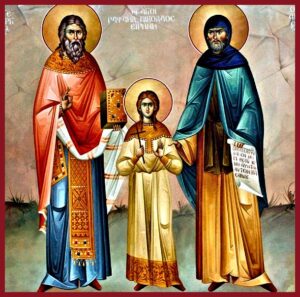
A master iconographer, Photios Kontoglou, wrote their icon, based on the description the Martyrs had revealed of themselves. Amazingly enough, we can see what they looked like.
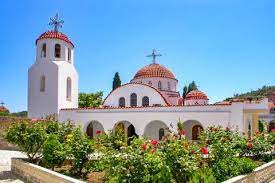
The story continues into our times. On the place of their martyrdom, a large monastery now exists, which receives thousands of pilgrims every year. Besides the relics of the saints and the catholicon (primary church) in honor of Saint Raphael, there is another church in honor of Saint Mary Magdalene, and also a building with thirty rooms for the nuns, two large guesthouses for pilgrims, and a museum. I read somewhere (can’t document it now) that nuns have come from many places in the world, sometimes after they also had visits from Saint Raphael.
There have, not surprisingly, been many reports of miracles. Here is one example: http://full-of-grace-and-truth.blogspot.com/
These Martyrs were formally recognized as saints by the Patriarch of Constantinople in 1970.
The questions I’m left with are: With so many unknown martyrs, why did these reveal themselves? and why in 1959, of all possible years? Only God knows the answers. We are left with the traditional Orthodox answer: “It is a mystery”.
Holy Martyrs Raphael, Nicholas, Irene and those with you, pray to Christ our God to save our souls.
If you want to know more of the story (and there is much more), you might read Dr Constantine Cavarnos’ “Modern Orthodox Saints series: Saints Raphael, Nicholas, and Irene of Lesvos“, available at https://www.amazon.com/gp/product/0914744887/ref=dbs_a_def_rwt_bibl_vppi_i0amazon!
For this Post my sources (where you can find much fuller accounts) were:
https://full-of-grace-and-truth.blogspot.com/2012/04/sts-raphael-nicholas-and-irene-newly.html
https://trueorthodoxy.org/teachings/los_new_martyrs_raphael_nicholas_irene.shtm
I also consulted the Orthodox Church in America and the Greek Orthodox Archdiocese.
2) Father Alexander Schmemann on Division and Unity
My wife Khouria Dianna sent this quote to me, so relevant to these times:
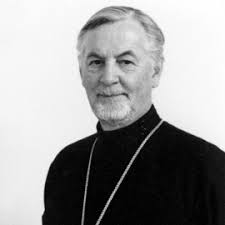
“For the world and man live by the law of division and opposition; everything on earth divides people – everything – even that which unites some of them: nationality, belief, ideology, taste, and so forth. The world’s sin and tragedy is that its entire life is fundamentally a war of all against all for the sake of self. Christ’s antidote to this division is unity or oneness, and oneness above all with God, oneness from above; for the closer people are to God, the closer they are to each other and to unity amongst themselves. Christ came to all and for all, and therefore in Christ, in His teaching, in His Life, people are able to find that oneness of faith, hope, and love which nothing else in this world can give, and which is finally the ultimate goal, the ultimate calling of the world and man: the unity of everyone and of everything in God. It is this oneness which is in fact the Kingdom of God, and it is this new oneness of all and everything in Christ which the Church is called to manifest, to serve, to bring into being in all places and in all times.”
(from his book For the Life of the World)
3) Pope Francis
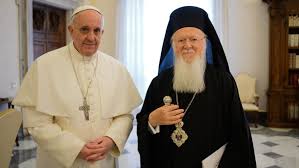
Besides having much in common with the Roman Catholic Church, it’s no secret that we Orthodox have a considerable number of theological and pastoral issues with them – not least among them their doctrine that they are ruled top down, with a Pope of Rome at the pinnacle. Nor would we agree with Pope Francis about all things, though he had a special interest in unity with Orthodoxy. I begin this way so you won’t think I’m making light of our divisions.
However, “Now abide faith, hope, love, these three; but the greatest of these is love.” 1 Corinthians 13:13 Saint Ignatius of Antioch addressed the Church in Rome and their bishop “who presides in love”. There can be no doubt that Pope Francis presided in love. He won people to Christ and invigorated the Church of Rome not by the imposition of authority, but by love.
Did you know that during the Gaza war, Pope Francis called the people of the Roman Catholic Church in Gaza every day, to comfort and cheer them. I think that’s all we need to know about the character of this holy man.
“May his memory be eternal.” “May light perpetual shine upon him.”
See:
https://www.bbc.com/news/articles/clyqgy6m8e6o
https://apnews.com/article/pope-francis-israel-hamas-war-gaza-31f1755f8426ec81cb07b29bff3db70e
https://www.npr.org/2025/04/22/g-s1-62064/pope-francis-gaza-church-palestinian-christians
Next Week: We Shall Be Like Him.” The Orthodox understanding of Salvation
Week after next: “I believe in One Holy Catholic and Apostolic Church.”